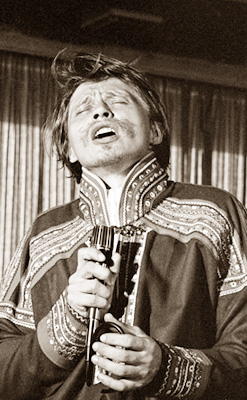Nils Aslak-Valkeapää (1943-2001) is a celebrated Sámi musician composer who integrated the indigenous Sámi musical practice of joikinto western compositional forms. The Sámi are indigenous to “the Arctic fringes of Europe, living across the Nordic countries and the Russian Kola Peninsula” (Ramnarine 2009: 188), and their musical practice of joikis described by ethnomusicologist Tina K. Ramnarine as “a vocal genre characterized by distinctive vocal timbres and techniques, in which the performer joiks(sings—though some commentators distinguish between “joiking” and “singing”) something rather than joiks about something” (ibid.). What does it mean to joik something rather than to joik about something? This is a musical act of presencing, of making-present, in which “the author, the musical form, and its object are one and the same (the joiker-joik-joiked complex)” (ibid.). In composing his Bird Symphony, Valkeapää spent two years recording birdsong in his home area and manipulated these recordings in order to create a three-dimensional sonic effect (ibid.: 202). Ramnarine gives the following succinct and evocative description of the symphony as a whole: “after 32 minutes and 2 seconds of recorded birdsong and waterscapes, a joik singer is introduced into the musical texture and is eventually joined by a second singer (singing a countermelody). The singers are preceded by reindeer bells. The joik gives way to the bird soundscape until the final stages of the symphony when it is repeated, first of all as if from a distance, gaining prominence, and once again giving way to the birdsong towards the end of the symphony” (ibid.: 201)
Joiking involves the crossing of ontological boundaries: a family member can be joiked, as can an animal or a landform or an element such as the wind. In all of these arrangements, the joik is a musical realm of cohabitation, a moment in which the person, animal, or object being joiked is made present through the ensounded intention of the joiker, and perceived as present by the joiker and by enculturated listeners. (source)




